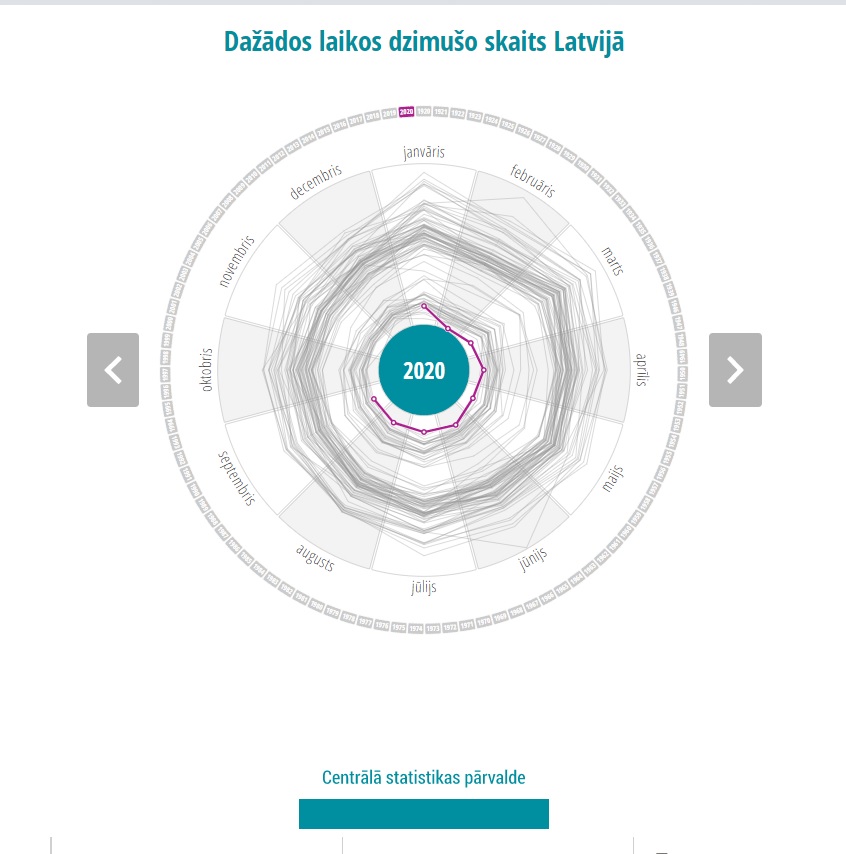Birth rates in Latvia, Estonia and Russia are declining, but in Lithuania they are collapsing

According to the publication of the Central Statistical Bureau of Latvia on the demographic indicators of the first nine months of 2020, the birth rate decrease by 5.1% in Latvia is between -4.9% in Estonia and -5.6% in Russia, while in Lithuania the birth rate decrease this year is -12.5 % against last year.
The percentage makes it possible to compare changes in birth rates, despite the differences in the number of newborns in Latvia and Russia. The percentage also evens out the purely technical difference that data collection in the giant Russia takes more time than in Latvia, so Rosstat has so far published demographics for only eight months.
In the first nine months of this year, civil registry offices in Latvia registered 13,503 newborns, while in Russia the number of newborns exceeds one million. The eight-month figure published is 938,295 children, but it is certain that nothing has happened in Russia that would prevent more than 100,000 children from being born in September. On the other hand, compared to Latvia, the huge number of newborns also provides an impressive reduction in the birth rate in absolute terms from 994,303 children in the eight months of last year to 938,295 children this year. In Russia, just the decrease in the birth rate in absolute numbers exceeds the total number of children born not only in Latvia, but throughout the Baltics. Last year, 14,099 newborns were registered in Estonia, 18,786 in Latvia and 27,399 in Lithuania, giving a total of 60,278 newborns. 70-80 thousand fewer children will be born in Russia this year than last year, if the trend already observed this year continues without a huge impact of Covid-19.
The similarity between Latvia and Russia is also such that in both countries the only place where the birth rate increases and exceeds the mortality is the territories around the capitals of both countries. Russia provides data on births later, but in more detail during the year. Thus, it turns out that the Moscow region has surpassed Chechnya and all other applicants for the first place in terms of birth rates at the borders of the Russian Federation. In the Moscow region, the number of newborns has increased by 6.3 thousand or 13.4% compared to the eight months of last year, while in Moscow itself it has decreased by 12.9 thousand children or 13.9%. Latvia does not give a breakdown of the birth rate by its municipalities in individual monthly sections, but the common indicators of previous years suggest that the birth rate in Mārupe or Ādaži is the same as in the clusters of new houses around Moscow.
In Estonia, as usual, everything is best according to the official phraseology that birth is something good. Maybe it's just a coincidence, which will not be confirmed by the whole of 2020, but by the end of September, the birth rate reduction in Estonia was just barely below 5%.
Lithuania, on the other hand, stands out with a very sharp decrease in the birth rate from 21.4 thousand to 18.7 thousand, compared to the last two nine-month periods. As a percentage, this reduction corresponds to -12.5%, which is difficult to reconcile with peacetime, which is not yet covered by the Covid-19 impact. It is possible that the final figures for the year will look a little better at the expense of children born abroad but registered in the Lithuanian state, but this will not change the conclusion that something has gone very wrong in Lithuania.
Even with a relatively moderate decrease in the birth rate, Latvia will not avoid the fact that 2020 will become the fourth in a row, when the total number of births will have to be recorded in the next thousand, which is smaller than in the previous year. 2016, with 21,968 newborns, raised hopes that the 22,000 mark would be exceeded son enough, but in fact, 2017 yielded 20,828 newborns. In the following years, 19,314 and 18,786 newborns followed. If the decrease in the number of newborns already registered this year compared to the first nine months of last year has reached 731 children, then October, November and December will take care of the number of births this year to only reach over 17 thousand. Unless some forces that push mass immigration into Latvia, then in the very near future the number of newborns in Latvia will get to be around 10 thousand a year.
The statistics, not malice, explain the Minister of Health Ilze Viņķele's efforts to find excuses and ways to close most of the remaining maternity hospitals in the country.
All other public authorities and private companies will have to adapt to a smaller number of children immediately afterwards, even if they have no direct connection with children. For example, food and household goods stores in rural areas of Latvia can exist only where there are people around who receive, firstly, salaries for childcare and education and, secondly, benefits for raising children. In another aspect, companies can count on the benefits that not having children will positively impact the work done by their employees. On the other hand, non-existent children also do not demand to eat, i.e. do not force their parents to accept just any salary for hard work. Those who do not have children have more time to look for a better job and a higher salary complete with giving more meaning to life. In the long run, entrepreneurs need to look at whether robots are at all possible, available and will pay off in their industry to take over the work that younger people are now doing.